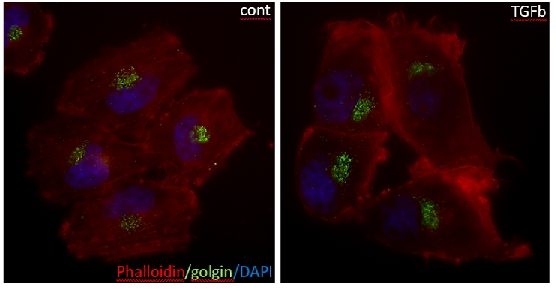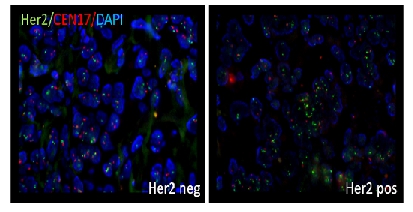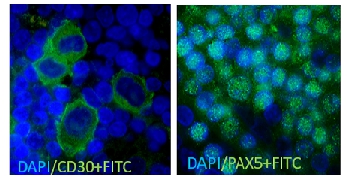Pathology, Neuropathology and Molecular Pathology
Research Focus
General Facts
Research
Selected Publications
Selected Funding, Collaboration
Keywords: Oncology, uropathology, haematopathology, oropharyngeal pathology, pathology of infections, neuropathology, transplantation, biobanking, molecular pathology, digital pathology
Research (ÖSTAT Classification) : 301101, 301103, 301105, 301107, 301108, 301109, 301114, 301206, 301211, 301301, 301306, 301402, 301405, 301904, 304002

Fig. 1: Human lung cancer cell line
Research Focus
Pathology, haematopathology, neuropathology, uropathology, infectiology, immunology and transplant pathology, biobanking, morphomics, molecular pathology, digital pathology
The research groups at the institute focus on bidirectional, medically relevant research: they translate basic research questions into clinical applications and clinical needs into basic research, in which various medically relevant questions are investigated. Their research activities are based on the solid molecular-pathological expertise of our team and the laboratories at the institute, with in-house core facilities for cytology, histology, immunohistochemistry and molecular pathology with genetic screening platforms such as oligo-microarray, array comparative hybridisation analysis, fluorescence in situ-hybridisation and particularly the unique resource from Biobank Innsbruck with accurate clinical information from our clinical collaborators. All these activities are strengthened by close connections within the Medical University of Innsbruck and by the support of many national and international collaborators.
General Facts
The Institute of Pathology, Neuropathology and Molecular Pathology focuses on diagnostic clinical pathology and is responsible for the routine pathological diagnosis of biopsies and surgical specimens obtained from clinical partners, with an emphasis on oncology, especially of the lymphatic tissue, the urogenital tract and oropharyngeal tumours. A large archive consisting of formalin-fixed paraffin-embedded material (FFPE) is located at the institute and this makes us an important connecting link between basic science and clinical research. This translational research is reflected by the close cooperation with clinicians and researchers in the fields of oncology, surgery, radiology, nuclear medicine, neurology, dermatology, head and neck as well as cranio-maxillofacial surgery, dermatology, gynaecology and many other departments.
Research
Topics and working groups (in alphabetic order)
Main topics include: diagnosis of rare tumour entities, tumour biology and mechanisms of treatment resistance, evaluation of biomarkers to predict individual risk and prognosis, support diagnosis and assist in treatment allocation, as well as identification of potential therapeutic targets using molecular pathological methods. Current projects are dealing with the early detection of lung cancer and the role of molecular pathology in therapy for lung cancer patients. The research groups for uropathology, haematopathology and cranial-maxillofacial surgery represent a particular field of interest at the institute.
Group statement:
Our success is based on excellent collaboration both with our pre-clinical and clinical partners in Innsbruck and externally.

Fig. 2: Molecular Diagnostics: FFPE Breast cancer
Anna Maria Birkl-Töglhofer, PhD
Computational tools represent an essential cornerstone in cutting-edge research to reveal underlying, complex, physiological and pathophysiological processes that lead to function and dysfunction at molecular and subsequent cellular level. The integration of applied bioinformatics together with wet laboratory experiments and imaging technology are crucial to significant progress in our fields of research. The research focuses on: a) neurodegenerative disorders including chronic pain, Alzheimer’s disease and Parkinson’s disease; b) neuro-oncology including glioblastoma and paediatric tumours; c) psychiatric disorders including bipolar disorder, schizophrenia and major depression. In addition to the evaluation of genomics, transcriptomics and other ‘-omics’ technologies, the role of eIFs and related pathways is a major interest in these research fields. Several collaborators from the Medical University of Innsbruck as well as further national and international collaborators facilitate multidisciplinary approaches.
Univ.-Prof. Dr. med. univ. Dr. sc. nat. Johannes Haybaeck
- Eukaryotic gene expression is a complicated process, which is regulated primarily on the levels of gene transcription and mRNA translation. The latter involves four main steps: initiation, elongation, termination and recycling. Translation regulation is achieved primarily during initiation, which is orchestrated by so-called eukaryotic initiation factors (eIFs). Understanding of their functions and how they work has evolved recently. Our main research focus is on how translation initiation and especially eIFs are involved in various diseases. As it has emerged that eIFs are critically implicated in various oncogenic processes, the various eIF members and their contribution to carcinogenesis are being investigated by the team. Furthermore, we are investigating eIFs as potential future diagnostic biomarkers and therapeutic targets.
- We are aiming to generate novel animal models for steatohepatitis and its concomitant diseases, i.e. liver fibrosis, cirrhosis and hepatocellular carcinoma (HCC), in order to imitate real human disease conditions. Using these valuable animal models, we investigate the molecular mechanisms of human liver diseases, with an emphasis on a number of signalling pathways, e.g. NF-kB, JAK-STAT, mTOR signalling.
- Steatohepatitis is a disease characterised by a fatty liver, ballooning hepatocytes, the formation of Mallory-Denk Bodies (MDBs), fibrosis and inflammation. It frequently leads to HCC formation and is becoming a leading health problem affecting a high percentage of world population. It is therefore crucial and meaningful to clarify its molecular mechanisms, in order to improve future diagnosis and treatment. Depending on its inducing factors, steatohepatitis is subdivided into two types: alcoholic and non-alcoholic steatohepatitis (ASH/NASH), although non-alcoholic fatty liver disease (NAFLD) does not automatically fulfil all the criteria of NASH. One of our interests here lies in the functional links among acute and chronic inflammation, liver cell injury, tissue damage, regeneration and hepatocellular carcinogenesis. To address these questions, certain features of steatohepatitis have been reproduced in our animal models by means of a variety of genetic modifications and treatments. MDB formation, a typical feature of steatohepatitis, is characterised by keratin reorganisation into aggregates and by binding to p62 (sequestosome-1). We are therefore investigating the contribution of keratins and p62 to steatohepatitis and steatohepatitis-driven HCC. Keratins 8/18 (K8/K18), the major intermediate filaments of digestive epithelium, are important for maintaining cell structure and signal transduction; their aggregates are typical features of several liver disorders, including ASH and NASH. Our aim is to determine the impact of inborn and acquired alterations of the K8/K18 architecture and its binding partner p62 in the occurrence and development of hepatitis and HCC. This will enhance our understanding of the roles and interactions of the K8/K18 cytoskeleton, p62 and specific modifier genes in HCC, which in turn will lead to new therapeutic approaches.
- Biomarkers
We are looking for good biomarkers that are relevant to the diagnosis, grading, treatment, and prognostic evaluation of human liver diseases (hepatitis, especially steatohepatitis, liver fibrosis, cirrhosis and HCC), colorectal cancer, brain intrinsic neoplasms and various other tumour entities, by conducting detailed morphological and molecular characterisation studies of human tissue specimens as well as cell biology studies.
The identification, characterisation and targeting of biomarkers in therapeutic approaches are major goals of our research group. Oncologically useful prognostic as well as predictive biomarkers are investigated in multiple research projects.
In particular, in the framework of national and international collaborations with leaders in the field, we are assessing novel biomarkers in cell culture, animal models including xenograft models, human primary and metastatic tumour tissue as well as blood. Our biomarker research also focuses on non-oncological diseases, such as degenerative disorders, with everyday use of all modern morphological and molecular tools. As such, we believe we represent a competent team that is a good collaborator for academic partners and the pharma industry in the fast-moving and extremely fascinating, exciting and challenging area of biomarker research. - Neuroscience research
In close cooperation with our clinicians, we cover all aspects of modern neuropathological research, ranging from basic questions to applied, clinically relevant goals. High-quality morphological investigations are complemented by modern molecular tools as well as in vitro cell culture systems and various animal models. We are interested in neuro-oncology, neuroimmunology and neurodegeneration. In addition to brain tumours – especially gliomas – our neuropathological and neurobiological research is focused on mechanisms that drive neurodegenerative disorders. In this field of research, we have intensive collaboration with the Department of Neurology and the Department of Clinical Neurobiology at the Medical University of Innsbruck.
Priv.-Doz. Dr. rer. nat. Claudia Manzl
One of the research interests lies in how radon exposure influences the development and progression of non-small cell lung cancer. In this project, together with collaborators Dr Pall and Dr Gamerith from Internal Medicine LK/MUI as well as Prof. Büttner and Prof. Merkelbach-Bruse from University of Cologne, molecular drivers are evaluated by means of NGS and FISH analysis and the results are correlated with the clinical outcomes and survival of patients from the Tyrol Tumour Register. A further project deals with the question of whether activation of the DNA mismatch repair system (MMR) correlates with MGMT promotor methylation and the clinical outcomes of glioblastoma multiforme (GBM) patients treated with temozolomide (funded by Medizinischer Forschungsfond – a medical research fund). Together with Dr Brawanski and Prof. Thomé from the Department of Neurology and Neurosurgery (MUI) as well as Prof. Höftberger (MUW), we are analysing >40 GBM patients for the expression of MMR, MGMT-status and looking for correlations with clinical data (OS, PFS, STUPP etc). The question of why and how tumour cells decide to migrate and undergo epithelial-mesenchymal transition (EMT) is being investigated using human lung cancer cells. In order to shed light on cellular movement and the trafficking of key proteins, live cell imaging and FRET-(FLIM) analysis will be performed using the Leica Falcon SP8 microscope at the institute.
Dr. med. univ. Georg Schäfer
The main topic in the field of uropathology is prostate cancer and the focus here is on tumour biology, mechanisms of treatment resistance, evaluation of biomarkers for diagnosis, risk prognosis and therapy allocation as well as potential therapeutic targets. Furthermore, the function of the androgen receptor and the role of stem cells, cytokines and inflammation in tumour progression and treatment resistance are evaluated in close co-operation with the Department of Urology. Another field of interest is in bladder cancer, currently concentrating on tumour immunology and especially on the role of the PD1/PDL1 axis in advanced and metastasised bladder cancer. Further projects are concentrating on biomarkers for risk, prognosis and resistance to BCG-therapy as well as the prevalence of HPV infection in superficial bladder cancer.
Dr.in med. univ. Susanne Sprung / Univ.-Prof. Dr. med. univ. Dr. sc. nat. Johannes Haybaeck
The main focus is on investigation of the role of various biomarkers in different tumour entities, especially in the female genital tract. To this end, we work in close cooperation with the clinical departments of Tirol Kliniken GmbH as well as many national and international collaborators.
Mag. Gudrun Thurner, PhD
Focus 1:
Richard Feynman´s famous lecture, „There is plenty of room at the bottom“ (1), inspired many researchers since the 1960s to explore the layers beyond the micrometer scale. Nanotechnology is indeed a fascinating field of multidisciplinary research with diverse fields of applications. I am working in this field since 2007 focussing mainly on the development of nanoparticles for imaging, diagnosis and treatment of cancer, thereby investigating how nanoparticles are functionalised with respective imaging agents and with antibodies as targeting groups. The aim of this research is to specifically image cancerous lesion sites in vivo, and be able to deliver cargo such as anti-cancer drugs specifically reducing adverse side effects. This research requires a multidisciplinary approach, covering the fields of chemistry, biochemistry, pharmacology, and physical methods. In view of potential applications in cancer diagnosis and treatment a crucial requisite is to quantify the target specificity of these functionalised nanoparticles by medical imaging and histological studies (collaboration with the Core Facility MicroCT, Department of Radiology, Medical University Innsbruck).
A further research focus is sensitive and high-resolution optical imaging (confocal laser scanning microscopy) to study cellular interactions in the context of Hodgkin lymphoma.
A further research focus concerns investigations of tailored histological and immunohistochemical techniques to be applied for studying neuropathologies (collaboration with the Department of Vascular Surgery, Medical University Innsbruck).
Fruitful national and international collaborations form the basis of these research activities.
(1) Feynman RP (1960) There is plenty of room at the bottom. Caltech Engineering and Science 23: 22 – 36
Selected Publications
- Mayr L, Grabherr F, Schwärzler J, Reitmeier I, Sommer F, Gehmacher T, Niederreiter L, He GW, Ruder B, Kunz KTR, Tymoszuk P, Hilbe R, Haschka D, Feistritzer C, Gerner RR, Enrich B, Przysiecki N, Seifert M, Keller MA, Oberhuber G, Sprung S, Ran Q, Koch R, Effenberger M, Tancevski I, Zoller H, Moschen AR, Weiss G, Becker C, Rosenstiel P, Kaser A, Tilg H, Adolph TE: Dietary lipids fuel GPX4-restricted enteritis resembling Crohn's disease. Nat Commun. doi: 10.1038/s41467-020-15646-6. 2020 Apr 14;11(1):1775.
- Schöpf B, Weissensteiner H, Schäfer G, Fazzini F, Charoentong P, Naschberger A, Rupp B, Fendt L, Bukur V, Giese I, Sorn P, Sant'Anna-Silva AC, Iglesias-Gonzalez J, Sahin U, Kronenberg F, Gnaiger E, Klocker H: OXPHOS remodeling in high-grade prostate cancer involves mtDNA mutations and increased succinate oxidation. Nat Commun. 2020 Mar 20;11(1):1487. doi: 10.1038/s41467-020-15237-5.
- Birkl-Toeglhofer, AM; Birkl, C; Llenos, IC; Weis, S; Haybaeck, J: Hepatic gene expression explains primary drug toxicity in bipolar disorder. Transl Psychiatry. doi: 10.1038/s41398-019-0666-4. 2019 Dec 9;9(1):331.
Selection of Funding
- Plasmablastic lymphomas
microenvironment Phase I: Plasmablastic lymphomas
Main sponsor: GILEAD - DNA mismatch repair in caspase 2
Deficient lung cancer cells
Main sponsor: Ingrid Shaker Nessmann - DNA mismatch
Repair and MGMT analysis in glioblastoma patients
Standard sponsor: MFF
Collaborations
- OrthoCincy Orthopaedics & Sports Medicine
R. Michael Greiwe, MD
560 South Loop Road
Edgewood, KY - Uniklinik RWETH Aachen
Clinic for Gastroenterology, Metabolic Disorders and Internal Intensive Medicine (Med. III)
Pauwelstraße 30
D-52074 Aachen - University Hospital Salzburg
Christian-Doppler-Klinik
University Hospital for Neurology
Priv.-Doz. Dr. Slaven Pikija
Ignaz-Harrer Straße 79
A-5020 Salzburg - Diagnostics / Research Institute for Pathology
Dr. med. uni. Martin Asslaber
Neue Stiftingtalstraße 6
A-8010 Graz - Childhood Cancer Research Institute and Institute of Neuropathology
University Medical Center Hamburg Eppendorf
Prof. Ulrich Schüller
Martinistraße 52
D-20246 Hamburg - Institute of Animal Breeding and Genetics, Department of Functional Cancer Genomics
Univ.-Prof. Dipl.-Ing. Dr. rer. nat. Richard Moriggl
Veterinärplatz 1
A-1210 Vienna - Institute of Pharmaceutical Biology
Saarland University
Prof.in Dr.in Alexandra K. Kiemer
Campus C2 3
D-66123 Saarbrücken - Tyrolean Cancer Research Institute
Translational Cancer Research
Innrain 66
A-6020 Innsbruck
Devices & Services
- Confocal microscope
 Univ.-Prof. Dr. med. univ. Dr. sc. nat. Johannes Haybaeck
Univ.-Prof. Dr. med. univ. Dr. sc. nat. Johannes Haybaeck
Director
Contact:
Müllerstraße 44
6020 Innsbruck
Austria
E-mail: pathology@i-med.ac.at
Phone: +43 512 9003 71301
Fax: +43 512 9003 73301
www.i-med.ac.at/pathologie




